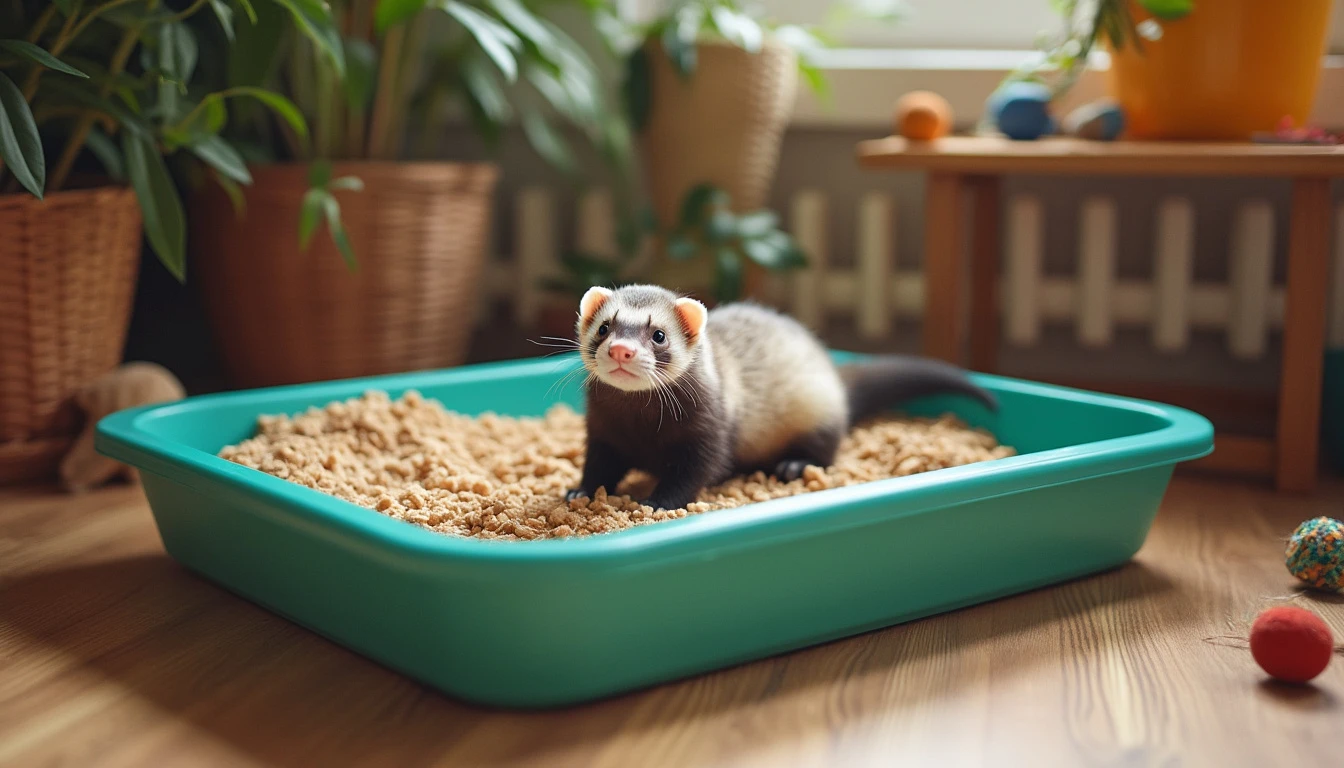Litter training your ferret can be a rewarding experience that enhances the bond between you and your pet while making your home cleaner and more pleasant. Ferrets are intelligent creatures, and with the right techniques and a little patience, you can teach them to use a litter box effectively. This guide will provide in-depth knowledge on how to litter train a ferret quickly, covering essential techniques, tips, and common mistakes to avoid.
Understanding Ferret Behavior
Before diving into the specifics of litter training, it’s essential to understand some basic ferret behavior. Ferrets are curious, playful animals that thrive on social interaction. They have a natural instinct to dig and burrow, which means they may view a litter box as just another play area.
Key Behavioral Traits of Ferrets:
- Curiosity: Ferrets explore their surroundings by sniffing, digging, and sometimes chewing.
- Territoriality: Ferrets are territorial animals. They may choose specific areas for elimination.
- Routine-oriented: Ferrets tend to follow routines, which can be advantageous when establishing a litter training schedule.
Understanding these behaviors can help you create an effective litter training strategy.
The Best Litter for Ferrets
Choosing the right litter is crucial to successfully litter training your ferret. Some litters can be harmful or unappealing to ferrets. Here are some recommended types of litter:
| Type of Litter | Description | Pros | Cons |
|---|---|---|---|
| Paper-based | Made from recycled paper, this litter is absorbent and safe. | Safe, low dust, biodegradable | May not control odors well |
| Wood pellets | Made from compressed sawdust, these pellets break down into sawdust when wet. | Good odor control, natural | Can be messy as they break apart |
| Corn-based | Made from corn byproducts, it’s biodegradable and clumping. | Good odor control, natural | Some ferrets may not like it |
| Clay-based | Traditional litter made from clay. | Good absorbency | Dusty and can be harmful if ingested |
Recommended Litter Brands
- Kaytee Clean & Cozy (Paper-based)
- Ökocat Natural Wood Cat Litter (Wood pellets)
- World’s Best Cat Litter (Corn-based)
Setting Up the Litter Box
To set up an effective litter box for your ferret, follow these steps:
- Choose the Right Location:
- Place the litter box in a quiet, accessible area away from food and water dishes. Ferrets like privacy when they relieve themselves.
- Select an Appropriate Size:
- Use a litter box that is low enough for your ferret to enter easily but spacious enough for them to turn around comfortably.
- Add the Litter:
- Fill the box with 1-2 inches of your chosen litter. Avoid overfilling, as ferrets can easily kick litter out of the box.
- Create a Routine:
- Introduce your ferret to the litter box as part of their daily routine. Encourage them to explore it after meals and naps.

Litter Training Techniques
Now that you have the litter box set up, it’s time to implement effective training techniques. Here are some steps to follow:
1. Positive Reinforcement
Use positive reinforcement to encourage your ferret to use the litter box. This could include:
- Treats: Reward your ferret with their favorite treat when they use the litter box.
- Praise: Use a cheerful tone to praise your ferret when they enter the box.
2. Consistency is Key
Be consistent with your training efforts. If your ferret has an accident outside the box:
- Clean Up Immediately: Use an enzymatic cleaner to eliminate odors, as ferrets are attracted to their own scent.
- Redirect: Gently place your ferret back in the litter box after an accident to reinforce where they should go.
3. Monitor Their Habits
Observe your ferret’s habits closely. If they tend to go in a specific spot, try placing a litter box there. Ferrets often choose one area to use for elimination, making it easier to redirect them.
Troubleshooting Common Issues
Problem 1: Refusal to Use the Litter Box
If your ferret refuses to use the litter box, consider the following:
- Litter Type: They may dislike the texture or smell of the litter. Experiment with different types.
- Location: Ensure the litter box is in a safe, quiet place.
Problem 2: Frequent Accidents
If your ferret has frequent accidents, try to:
- Increase the Number of Boxes: Place additional litter boxes around the house to provide more options.
- Adjust the Training Schedule: Be more proactive in directing your ferret to the box after meals or play sessions.
Case Studies and Success Stories
Case Study 1: The Rescue Ferret
Name: Bella
Background: Bella was a rescue ferret who had never been litter trained before being adopted by her new owner, Sarah. Bella initially struggled to understand the concept of a litter box and often eliminated in various corners of the house.
Challenges:
- Bella was fearful of the litter box and would avoid it altogether.
- Sarah faced frustration as she found messes in unexpected places.
Solutions:
- Sarah started by placing Bella in the litter box after every meal and when she woke up from naps, which helped Bella associate the box with these routines.
- She used soft paper-based litter that was comfortable for Bella and allowed her to feel safe. Sarah also placed Bella’s bedding in the litter box to make it more inviting.
- After a week of consistent training and positive reinforcement, Bella began using the litter box effectively, and Sarah celebrated each success with treats and praise.
Case Study 2: The Young Ferret
Name: Max
Background: Max was a young ferret who had just been adopted. His owner, Tom, was eager to teach him how to use the litter box from day one.
Challenges:
- Max was energetic and easily distracted, making it hard for him to focus on the litter box.
- Tom initially struggled with Max’s accidents outside the box during playtime.
Solutions:
- Tom implemented a strict training schedule, placing Max in the litter box every morning and after meals. He quickly noticed that Max was more likely to use the box when he was on a routine.
- He created a designated play area with an additional litter box nearby, which helped Max learn where to go when he felt the urge.
- Within days, Max was using the box independently, and Tom was thrilled with the progress.
Additional Tips for Litter Training Older Ferrets
Training older ferrets can present unique challenges compared to younger ones. Here are some tailored strategies for litter training older ferrets:
Understand the Background
Older ferrets may have established habits that are hard to change. If they have never been litter trained or have been in a less-than-ideal environment, it might take more time and patience to retrain them.
Use Familiar Scents
Older ferrets are particularly sensitive to scents. If you’re adopting an older ferret, try to incorporate bedding or toys that carry familiar scents. This familiarity can make them feel more comfortable approaching the litter box.
Be Patient and Observant
Take your time when training an older ferret. Observe their behavior closely to determine when they are most likely to need to use the litter box. Some older ferrets may also face health issues that affect their bathroom habits, so it’s essential to consult a veterinarian if you notice persistent problems.
Create Accessibility
Ensure that the litter box is easily accessible. Older ferrets may have mobility issues, so consider a litter box with low sides that is easy for them to enter and exit.
Conclusion
Litter training your ferret can take time and patience, but with the right techniques and a commitment to consistency, you can achieve success. Remember to choose the right litter, set up a comfortable box, and reinforce positive behaviors. By understanding your ferret’s natural tendencies and needs, you can foster a clean and enjoyable environment for both you and your pet.
If you found this guide helpful, please leave a comment below sharing your own experiences with litter training a ferret! Don’t forget to share this article with fellow ferret lovers or subscribe to our blog for more tips and tricks on caring for your furry friends!
For further reading, consider exploring resources on ferret behavior and care to deepen your understanding. Happy litter training!
